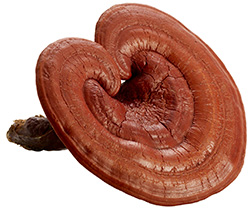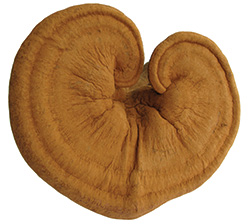Red Reishi
The Real Magic Mushroom
References
1. Lai et al. (2010) Immunomodulatory and adjuvant activities of a polysaccharide extract of Ganoderma lucidum in vivo and in vitro. Vaccine, 28, 4945 - 4954.
2. Li, Y., Wang, S. (2006) Biotechnol Lett, 28, 837-841.
3. Liu, W., Xu, J., Jing, P., Yao, W., Gao, X., Yu, L. (2010). Preparation of a hydroxylpropyl Ganoderma lucidum polysaccharide and its physiochemical properties. Food Chemistry, 122, 965-971.
4. Lin, Z. (2005). Cellular and molecular mechanisms of immuno-modulation by Ganoderma lucidum. Journal of Pharmacological Sciences, 99, 144-153.
5. Rubel et al (2011). Hypolipidemic and antioxidant properties of Ganoderma lucidum (Leyss:Fr) Karst used as a dietary supplement. World J Microbiol Biotechnol, 27, 1083-1089.
6. Russell, R., Paterson, M. (2006). Ganoderma – A therapeutic fungal biofactory. Phytochemistry, 67, 1985-2001.
Sliva, D. (2004). Cellular and physiological effects of Ganoderma lucidum (Reishi). Mini-Reviews in Medicinal Chemistry, 4, 873-879.
7. Zhu, M., Chang, Q., Wong, L.K., Chong, F.S., Li, R.C. (1999), Triterpene antioxidants from Ganoderma lucidum. Phytotherapy Research, 13, 529-531.
|
Red Reishi (Ganoderma Lucidum), commonly known as Ling Zhi in Chinese, is a rare mushroom that has been used in Japan and China for over 2,000 years and revered by emperors and royalty for its effective but safe medicinal benefits. It was classified as an herb of superior class.1, 6 Various compounds, including polysaccharides, triterpenoids (ganoderic acid), proteins, and phenols, can be extracted from the fruiting bodies of Red Reishi. Synergistic effects of these compounds have been linked to a range of therapeutic effects for 5, 6, 7:
|
 Red Reishi (Not mature, yet to release spores) |
What are the active ingredients of Red Reishi?
|
Polysaccharides - modulate immune system, protect inner wall of stomach and anti-oxidation
Triterpenoids and Phenols Other organic compounds such as triterpene and phenols, along with polysaccharide, also produce a synergistic antioxidant effect.7, 8 Reactive Oxygen Species (ROS) are responsible for most oxidative damage among internal organs. When ROS stumbles upon lipid molecules, lipid peroxidation occurs and can lead to ischemia reperfusion injury, coronary artiosclerosis, diabetes mellitus and other mutagenic or carcinogenic cellular damage.3, 5 Organic compounds present in Red Reishi stimulate antioxidation by interrupting and inhibiting the oxidation chain reaction of ROS with lipid or other molecules.7, 8 |
 Bottom part of mature Red Reishi's cap with spores |
References
1. Lai et al. (2010) Immunomodulatory and adjuvant activities of a polysaccharide extract of Ganoderma lucidum in vivo and in vitro. Vaccine, 28, 4945 - 4954.
2. Li, Y., Wang, S. (2006) Biotechnol Lett, 28, 837-841.
3. Liu, W., Xu, J., Jing, P., Yao, W., Gao, X., Yu, L. (2010). Preparation of a hydroxylpropyl Ganoderma lucidum polysaccharide and its physiochemical properties. Food Chemistry, 122, 965-971.
4. Lin, Z. (2005). Cellular and molecular mechanisms of immuno-modulation by Ganoderma lucidum. Journal of Pharmacological Sciences, 99, 144-153.
5. Rubel et al (2011). Hypolipidemic and antioxidant properties of Ganoderma lucidum (Leyss:Fr) Karst used as a dietary supplement. World J Microbiol Biotechnol, 27, 1083-1089.
6. Russell, R., Paterson, M. (2006). Ganoderma – A therapeutic fungal biofactory. Phytochemistry, 67, 1985-2001.
Sliva, D. (2004). Cellular and physiological effects of Ganoderma lucidum (Reishi). Mini-Reviews in Medicinal Chemistry, 4, 873-879.
7. Zhu, M., Chang, Q., Wong, L.K., Chong, F.S., Li, R.C. (1999), Triterpene antioxidants from Ganoderma lucidum. Phytotherapy Research, 13, 529-531.


